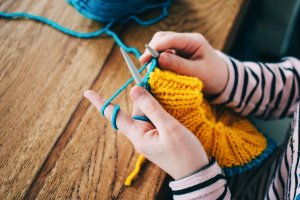A Stitch in Time Saves Lives: 3 Surprising Recovery Tools
A man, who had battled substance abuse for decades and rotated in and out of prison, stumbled upon an approach that helped reverse the course of his life. While behind bars, he saw a loom hook, which is a knitting tool. This item was there for a program to teach inmates how to knit. Intrigued, he enrolled. He quickly put this new found skill to use by making warm knitted caps – or toques — for the homeless. The upshot? Miraculously, this pastime broke the cycle of his addiction.
After his release from prison, he continued this hobby at an addiction services center. Other clients there observed him and joined in. His story captured the attention of the media. In a CNN post entitled “A man started a knitting group to help people like himself recover from drug addiction,” he shared his thoughts. He mused about how knitting is a precise craft. You can’t deviate from the process or take shortcuts. “You just have to follow every step, one at a time over and over again,” he explained. It’s painstaking. “But if you follow that routine, you are gratified with a toque at the end,” he said. “It sounds like a small thing, but to start a toque and finish it and then give it to someone, it’s sparked joy in me that I have never felt before in my life.”
Knitting and Recovery
The person at the center of this story found this tool to support his recovery. So did others who followed his lead. A fellow knitter in the addiction services program had struggled with substance use to the extent that he tried to take his own life. That was then. He told CNN: “After almost four years of addiction, it was time to turn my life around.” He praised the benefits he derived from the knitting circle. “Our knitting group has helped me by keeping my mind busy and giving me a sense of community,” he reported. “I’ve connected with everybody in our looming group and have learned some quality of life lessons from sharing with the group during my time here.”
The story does not stop at this point. The fruits of their knitting labor went on to good use. The toques they craft not only make their way to residents of homeless shelters, but also to others. Recipients include single mothers who give them to their children. They also are making “tiny infant toques” for babies. CNN noted that the members of the knitting circle “made positive life choices on their own.” From feeling good, they are doing good deeds to benefit others.
Gardening and Recovery
Two other outlets prove helpful for those in recovery: gardening and art projects.
Planting, fertilizing, watering and weeding may turn out to be of more value than just gardening. One woman, who recently had relapsed, reflected on this new hobby: “It’s a great way to connect with my higher power in the morning.” To that she added: “The garden is just such a peaceful, tranquil place to be…. I feel amazing. There is hope.” She and 30 residents in a transitional living facility are “feeling better than ever thanks in part to a community garden.” CBC News featured this feedback in a post on how a “Community garden brings hope, relief for women in recovery.”
A counselor at the residence noted that this seed-to-table program offers an array of pluses. Those in recovery who are taking part in it come away with a lot. They learn to work with the soil to grow their food as well as make their meals with it. “Gardening is so beneficial in so many ways,” she stated. “It gets women outside and it gives them purpose.”
Art and Recovery

As for art, Oxford Treatment Center uses it as a form of experiential therapy with clients. It’s an adjunct to the formal treatment program. As such, it meets many needs. This approach to recovery “addresses emotional and spiritual needs through creative or physical therapy.” There are no requirements, such as formal training and talent, for anyone to participate. Just come to the sessions and join in. “Many clients find that art therapy is a relaxing and enjoyable way to address some of the more complex aspects of rehab,” they explain. “Creative activity provides a way to process some of the stressful emotions and anxieties during treatment.”
This tool has an enduring component. Some clients, after leaving rehab, continue down this path. Once their artistic spark gets ignited, they keep the flame going by painting and drawing on their own. This facility within American Addiction Centers advises that art is “a way to express feelings, explore creativity, and reduce stress.”
If you or a loved one is struggling with substance use, don’t go it alone. American Addiction Centers is here to help. Your recovery begins here.
